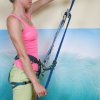Sorry for the (most likely) noob question but I'm really new to the saddle hunting community and I've jumped straight into one-sticking.
I thought I'd done a lot of research before ordering equipment and I've found this site to be extremely helpful. However, I'm having some issues with my setup that I'm hoping people can help me with.
I've got a Mammut 2.0 with:
Black Diamond carabiner: https://www.amazon.com/gp/product/B081B7WYFM/ref=ppx_yo_dt_b_asin_image_o02_s00?ie=UTF8&psc=1
Here's my rope: https://www.amazon.com/gp/product/B000C6DJTQ/ref=ppx_yo_dt_b_asin_image_o02_s02?ie=UTF8&psc=1
The reason I posted what rope I'm using is because I can't get the setup to stop slipping a lot! I've got to put WAY more pressure on the brake rope than I thought I would to keep it from slipping. I don't know if it's the wrong carabiner even though I've seen people who said they used this kind. Then I was wondering if I got the wrong kind of rope.
I had a backup below the mammut and I just saw someone posted a pic of a backup above the mammut which is a really interesting idea. I noticed that it being below caused the saddle to lean and it wasn't very comfortable.
Thanks for any help on this.
I thought I'd done a lot of research before ordering equipment and I've found this site to be extremely helpful. However, I'm having some issues with my setup that I'm hoping people can help me with.
I've got a Mammut 2.0 with:
Black Diamond carabiner: https://www.amazon.com/gp/product/B081B7WYFM/ref=ppx_yo_dt_b_asin_image_o02_s00?ie=UTF8&psc=1
Here's my rope: https://www.amazon.com/gp/product/B000C6DJTQ/ref=ppx_yo_dt_b_asin_image_o02_s02?ie=UTF8&psc=1
The reason I posted what rope I'm using is because I can't get the setup to stop slipping a lot! I've got to put WAY more pressure on the brake rope than I thought I would to keep it from slipping. I don't know if it's the wrong carabiner even though I've seen people who said they used this kind. Then I was wondering if I got the wrong kind of rope.
I had a backup below the mammut and I just saw someone posted a pic of a backup above the mammut which is a really interesting idea. I noticed that it being below caused the saddle to lean and it wasn't very comfortable.
Thanks for any help on this.


